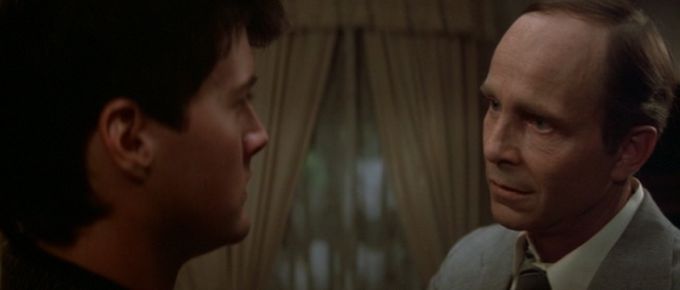 Back to selection
Back to selection
The Blue Velvet Project
Blue Velvet, 47 seconds at a time by Nicholas Rombes
The Blue Velvet Project, #122

Second #5734, 95:34
There is a look of pity on Detective Williams’s face as he delivers his warning to Jeffrey not to “blow it.” At this point, it’s not entirely clear whose side the Detective is on; is his Hollywood stock detective outfit for real, or is he—like the “well-dressed man”—wearing a disguise? His warning to Jeffrey, as he takes him by the arms and looks into his eyes, is like a secret communication, a signal to Jeffrey not to rush things, not dig too deeply because what he might find at the terrible, rotten core of things is not Frank, but Detective Williams himself.
This narrative possibility remains open at this moment, a moment that is among the film’s most terrifyingly ambiguous. Is the Detective—like Leland Palmer in Twin Peaks four years later—a monster disguised as a Man of Order? It is during scenes like this that Blue Velvet most closely echoes another film that deconstructed the idyllic myth of small-town America: Hitchcock’s Shadow of a Doubt (1943), whose Uncle Charlie operates as an earlier incarnation of Frank Booth, barely restrained by Hollywood’s Production Code. Of that film, Robert B. Ray, in A Certain Tendency of the Hollywood Cinema, 1930-1980, has written:
‘You live in a dream world,’ Uncle Charlie told his niece, ‘and I have brought you nightmares,’ a lesson that the film’s conclusion, despite its formal closure, could not completely contain. It was no answer to hear from the detective that the world was fundamentally sound, that ‘It just has to be carefully watched.’ By filming this speech in front of a church, and over the background sound of a minister’s glowing eulogy of Uncle Charlie, Hitchcock suggested that such reconciliations rested on hypocrisy.
Jeffrey also lives in a dream world, which he exchanges briefly for a nightmare world. In any case, neither of them is true. The world is not a binary of innocence (Sandy) and evil (Frank), but rather both of these—and everything in between—at once. Blue Velvet, like Shadow of a Doubt, recognizes this, and in doing so creates an ending that establishes a false Restoration of Order. Until then, we are left with this image at second #5734 as Detective Williams warns Jeffrey not to “blow it,” not to rush the ending, but to let the rest of the film unfold, to await the return of the mechanical, false robins.
Over the period of one full year — three days per week — The Blue Velvet Project will seize a frame every 47 seconds of David Lynch’s classic to explore. These posts will run until second 7,200 in August 2012. For a complete archive of the project, click here. And here is the introduction to the project.
